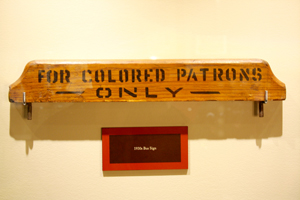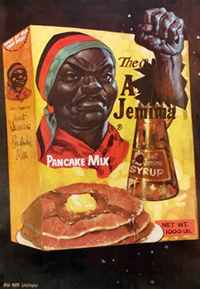Jim Crow Museum
1010 Campus Drive
Big Rapids, MI 49307
[email protected]
(231) 591-5873
I know this may sound like an odd question but do you have a favorite object in the museum?
--Karen Jenkins - Los Angeles, California

It is not a weird question, but I am not sure what you mean.
If by favorite you mean the object that I most enjoy using as a teaching tool, then the answer is a "For Colored Patrons Only" sign. During the Jim Crow period, a black person might begin a bus or train ride near the front, but each time a white passenger boarded, the African American passenger had to move back a row. An added indignity was that black passengers were often the ones forced to carry and re-position the segregation sign. This sign in the Jim Crow Museum is an authentic one used on trains and buses in Louisiana in the 1920s. It was donated to the Museum by a white woman from Michigan who visited Louisiana as a teenager. She was offended by the sign and the racial hierarchy (Jim Crow) that it represented, so...she "appropriated" the sign. Many decades later she donated it the Museum because she wanted people to remember the indignities of segregation.

If by favorite you mean the object that speaks to and reflects my struggle/journey, then it is Jon Onye Lockard's painting, "No More." Lockard, a painter, educator, and activist, taught life drawing, portrait painting, and the art and culture of African Americans for more than forty years at the University of Michigan and at Washtenaw Community College. "No More" was Lockard's way of deconstructing--oh, I hate that word--the racist imagery of African American women as happy, obedient, mammies. It is a powerful critique of mammy imagery and it demonstrates that blacks did not passively accept the assault on their images.
But, if by favorite you mean the object that I am most pleased to display, then the object is one of the ink pens that President Lyndon Baines Johnson used to sign the Civil Rights Act of 1964 into law. This landmark legislation outlawed many forms of discrimination against racial, ethnic, national, and religious minorities, and women. As relates to our work in the Museum, this Civil Rights Act ended de jure (legal segregation). In other words, it represented the beginning of the death of legalized Jim Crow practices. I bought the pen for twenty dollars from an eBay seller. It was worth every dollar and much more because it is a symbol of the United States' promise as a truly inclusive culture, a nation that belongs to all of us as much as it belongs to any of us.
Dr. David Pilgrim
Curator
Jim Crow Museum